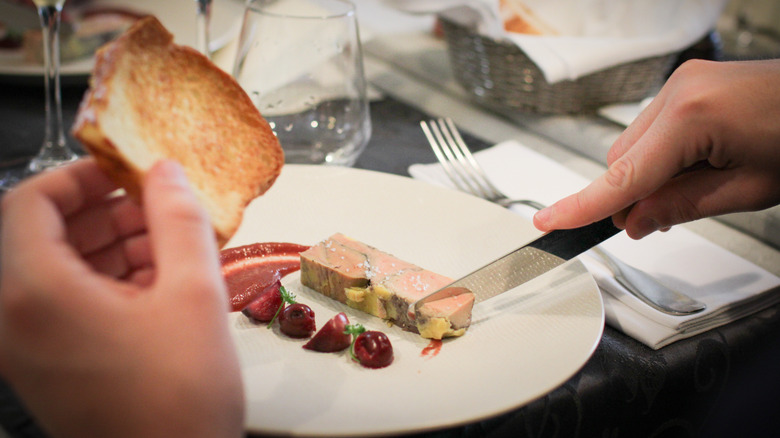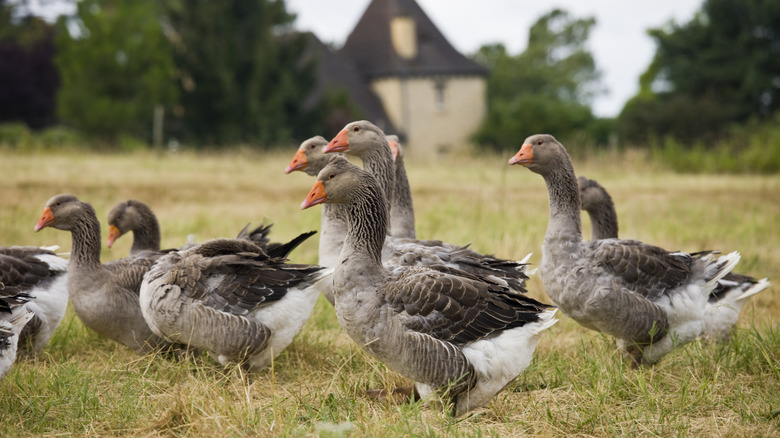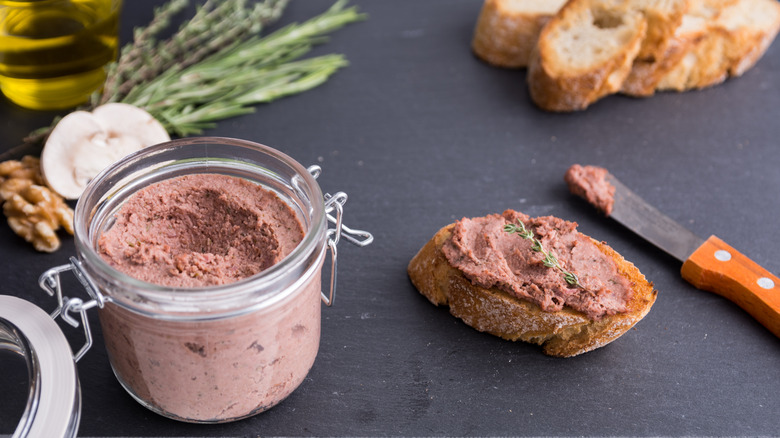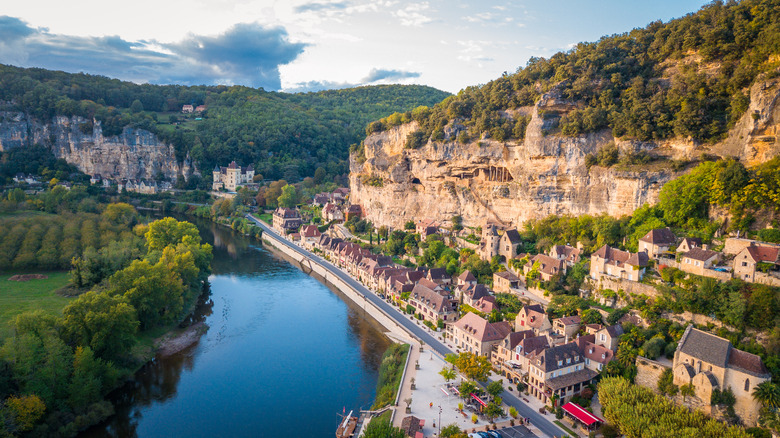The French Region That Produces Most Of The World's Foie Gras
When it comes to luxury, gourmet food items, foie gras is arguably up at the top of the list, alongside caviar and truffles. Expensive, elusive, and controversial in America, foie gras is a French delicacy whose name translates to "fat liver" because that is exactly what it is: a fattened liver from a goose or duck. It is far rarer to find it in the US outside of big city gourmet markets with the best selection of treats, but in France, a whole foie gras, mousse, or pate is easily attainable. And while it is especially served there during special occasions and celebrations, it is not unusual to enjoy foie gras outside these events, according to Snippets of Paris.
In what may come as a surprise, foie gras is actually not a French creation. Website Visit Dordogne Valley says that it was the Egyptians who discovered the joys of consuming fattened duck and goose liver. To get ready for their annual migration, the local birds would deliberately stuff themselves with corn, thus fattening up their bodies and organs. Once the French caught on, there was no turning back. Today, the French produce 79% of the world's supply of foie gras, according to Food Charmer, but they also consume 78.5% of that. While various regions of France may make wine and cheese, it is one small area of the country that makes almost all of the foie gras.
Find foie gras in Dordogne
According to Visit Dordogne Valley, Dordogne, also known as Périgord, produces 90% of France's foie gras. Located in southwest France, about a two-hour drive from the Bordeaux airport, Dordogne is known for its medieval villages, numerous castles, and caves with prehistoric paintings. It is a valley town built around the Dordogne River that offers idyllic landscapes for visiting tourists, and plenty of grazing options for local ducks and geese, per Trip USA France. You may also recognize the area as the location where the famous Périgord black truffles are produced.
Foie gras producers in Dordogne take the treatment of their ducks and birds seriously to protect the centuries-long production of foie gras, which has cultural and gastronomic importance in the country. Visit Dordogne Valley says that French law prevents birds from being harmed in the production process, but Dordogne farmers take it a step further, making certain that their birds live a stress-free life. The site says that the birds enjoy perfect weather, abundant outdoor or free-range time, and are fed local corn, nothing chemically-treated. While critics of foie gras believe the practice of force-feeding is cruel, Food Charmer mentions that ducks and geese are naturally predisposed to eating as much food as they are given. The animals are also not bred solely for their livers; the breast meat is sold while the bird's wings, legs, and giblets are turned into confit, furthering France's reputation for not wasting any part of an animal.
The many forms of foie gras
Once processed, the foie gras is sold in a variety of forms. Snippets of Paris explains that it can be sold whole or "entier," as a "bloc de foie gras" or smaller livers that are assembled together and molded, "foie gras avec morceaux," or a block that has been formed together with a mix of duck and goose livers. Foie gras is available fully cooked or uncooked, in which case it is usually cut into thick slices and seared before serving.
Most of the foie gras produced and sold in France comes from ducks, with the goose version being rarer and, thus, more expensive. A whole foie gras and even "bloc" versions can be pretty expensive, and if they are not in your budget, you can still get the flavor from mousses and pate de foie gras, which are both abundantly available in Dordogne. The Spruce Eats explains they are usually made from about half fattened duck liver and half other meat ingredients.
Come for the foie gras, stay for much more
Dordogne may be renowned for its foie gras and truffles, but this is a town worth fitting into your next trip to France for a number of reasons. From a gastronomical point of view, Dordogne produces terrific wines, strawberries, walnuts, caviar, and cheeses, per Le Guide du Périgord. As of 2022, there were eight Michelin-starred restaurants in the region, offering exciting dining opportunities for hungry travelers. Gourmands will also love the numerous farmer's markets selling everything from artisan products and souvenirs to, of course, the area's gorgeous foods, per Trip USA France.
According to the website, Dordogne has been nicknamed the "land of 1001 castles," including one formerly owned by Josephine Baker called Chateau des Milandes. Many of the castles are in pristine condition and offer a look at medieval living, not to mention stunning views of the valley, which can also be obtained by experiencing a hot air balloon ride. Walking through the villages of Dordogne, you may think you've stepped back in time with their tiny streets, sidewalk cafes, churches, and classic French charm. You might even recognize the town of Beynac-et-Cazenac from the 2000 movie "Chocolat." And if history is your forte, you must experience the region's many Paleolithic sites, most notably the Lascaux Cave, which features cave paintings from 17,000 BC. Even without the foie gras, a stay in Dordogne may have you never wanting to leave.



